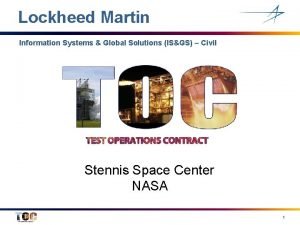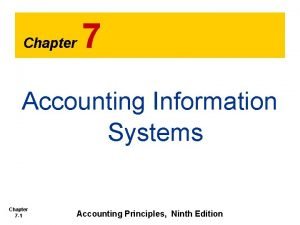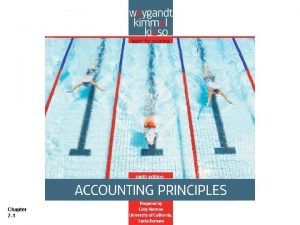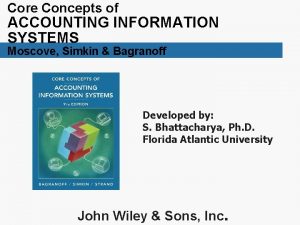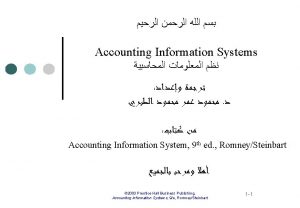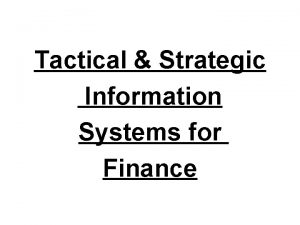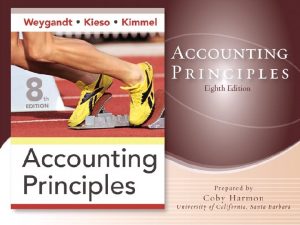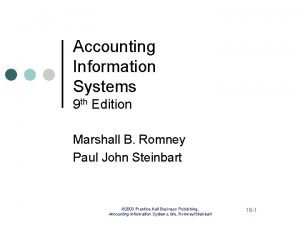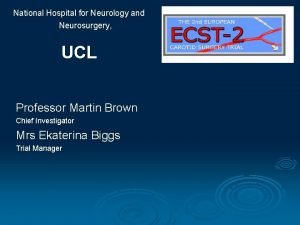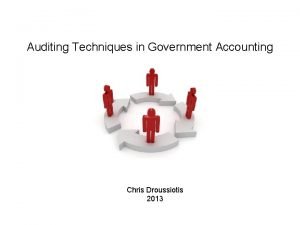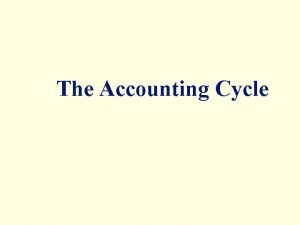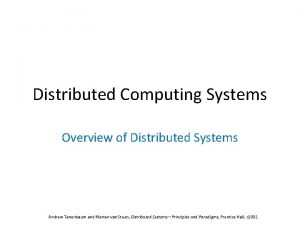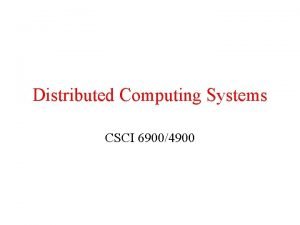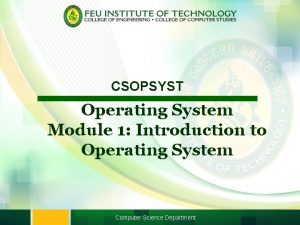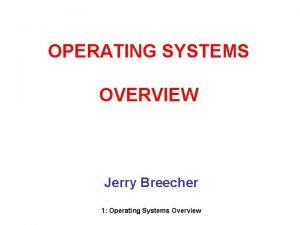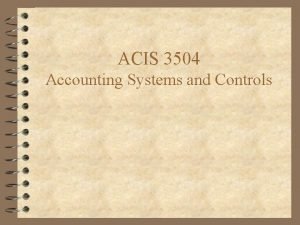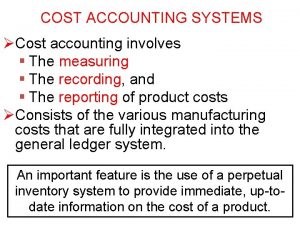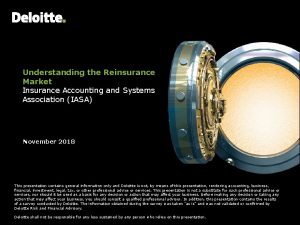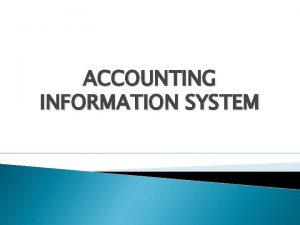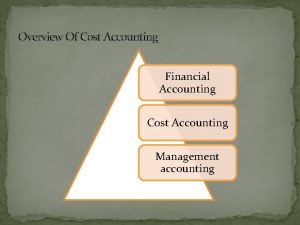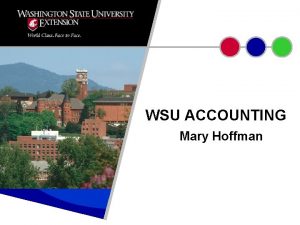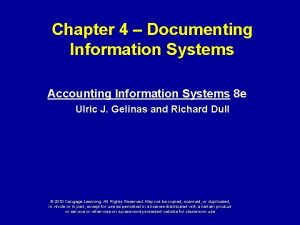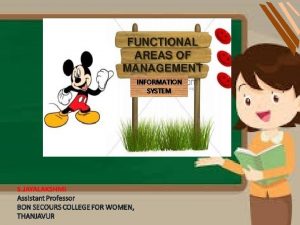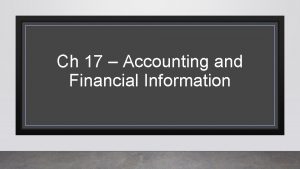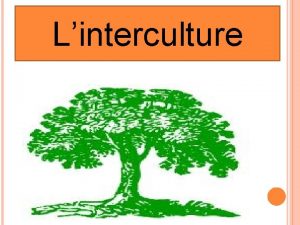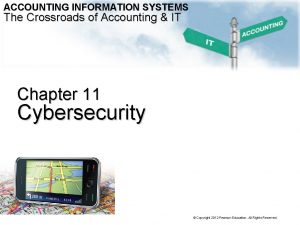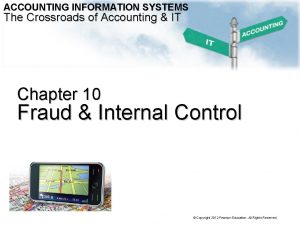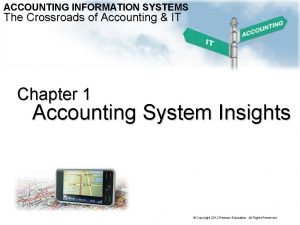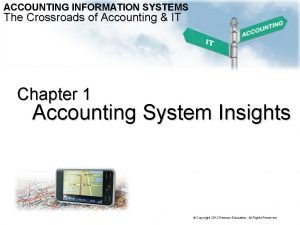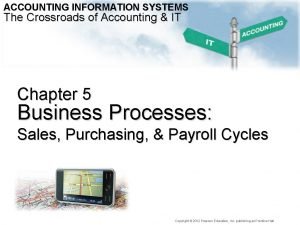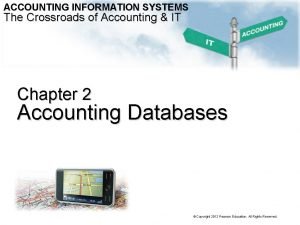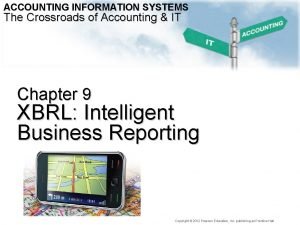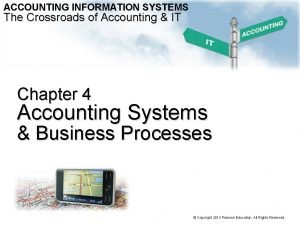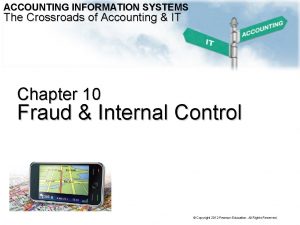Accounting Information Systems An Overview Professor Martin Professor





























- Slides: 29

Accounting Information Systems: An Overview Professor Martin Professor Xiong CSUS This lecture is based primarily on Romney & Steinbart(2003). It also draws on Martin (2002). Updated on: Monday, September 3, 2003

Chapter 1 Overview of AIS Agenda § § § The Accounting Information System (AIS) Why study AIS? The Role of AIS In the Value Chain

What is information System? t A system is a set of two or more interrelated components that interact to achieve a goal. t Systems are almost always composed of smaller subsystems, each performing a specific function supportive of the larger system.

Components of AIS u People u Procedures u Data u Software u Information technology

AIS Functions • • • Collect and store data about activities and transactions • Transaction Processing Systems (TPS) Process data into information useful for making decisions Provide adequate controls to safeguard organization’s assets

The Scope of AIS • Management Science MANAGEMENT INFORMATION SYSTEMS Distinguishing Feature = Transaction Processing for Accountability Purposes • Behavioral & Organizational Science • Supply Chain • Computer Science ACCOUNTING INFORMATION SYSTEMS • Financial Reporting ACCOUNTING • Managerial Decision Making • Auditing & Control • Taxation Source: JIS editorial, 1989

BUSINESS PROCESS DEFINITION: A business process is a set of activities that takes one or more types of inputs and turns them into an output of greater value to the customer (Hammer) cookie Exchange or Transformation cash

$$ Cash payment $$ raw materials $$ payment purchase labor $$ $$ logistical operation labor acquire payment facilities, services & technology labor delivered raw manufactured materials goods labor material issue manufacture operation payment service acquire $$ Example Value Chain (source, make, _______ deliver) ______ shipment manufacture job sale labor service operation delivered manufactured goods service contract payment product services Source: eb. XML BP Catalog

$$ Cash receipt $$ Cash paymnt $$ raw materials $$ payment purchase labor $$ $$ logistical operation labor acquire payment facilities, services & technology labor delivered raw manufactured materials goods labor material issue manufacture operation payment service acquire $$ Example Value Chain (per Porter and SCOR) shipment manufacture job sale labor service operation delivered manufactured goods service contract cash rec product services Source: eb. XML BP Catalog

AIS Subsystems § § § Expenditure cycle: buying and paying for goods or services used by organization Production cycle: converting raw materials and labor into finished goods Human resources/payroll cycle: hiring and paying employees

AIS Subsystems § § Revenue cycle: selling goods or services and collecting payment Financing cycle: obtaining necessary funds to § run organization § repay creditors § distribute profits to investors

AIS Subsystems Data Funds Financing Human Resources Finished Goods Raw Materia ls or General Ledger b La Cash Revenue Funds Expenditure Production

Agenda § § § The Accounting Information System (AIS) Why Study AIS? The Role of AIS in the Value Chain

Why Study AIS t – – In Statement of Financial Accounting Concepts No. 2, The FASB. . . defined accounting as an information system. stated that the primary objective of accounting is to provide information useful to decision makers.

Why Study AIS? t To understand how the accounting system works. u How to collect data about an organization’s activities and transactions u How to transform that data into information that management can use to run the organization u How to ensure the availability, reliability, and accuracy of that information

Why Study AIS? Auditors need to understand the systems that are used to produce a company’s financial statements. t Tax professionals need to understand enough about the client’s AIS to be confident that the information used for tax planning and compliance work is complete and accurate. t

Why Study AIS? t t One of the fastest growing types of consulting services entails the design, selection, and implementation of new Accounting Information Systems. A survey conducted by the Institute of Management Accountants (IMA) indicates that work relating to accounting systems was the single most

1. 2. 3. 4. 5. Ten Most Important Activities Performed By Long-term 6. Financial and Accountants strategic planning Managing the accounting and finance function Accounting systems and financial reporting Internal consulting Short-term economic analyses 7. Process improvement 8. Computer systems and operations 9. Performance evaluation 10. Customer and product profitability

Technology and the Accounting Curriculum Responses from 151 universities and 62 firms ( survey by Hastings et al. (2002) 5 areas out of 14 are seen by % of respondents as needing coverage to 3 weeks or more t Excel (80%) t Access (74%) t E-Business Concepts (61%) t System Security (52%)

New Designations t t Certified Information Technology Professional (CITP) Certified Information Systems Auditor-Newest Designation (CISA) Identifies CPAs who possess a broad range of technological knowledge and the manner in which information technology (IT) can be used to achieve business objectives Reflects the AICPA’s recognition of the importance and

Agenda § § § The Accounting Information System (AIS) Why Study AIS? The Role of AIS in the Value Chain

The Value Chain Value chain consists of 9 interrelated activities t 5 primary activities consist of: u receiving and storing materials, manufacturing, marketing, and delivering products / services to customers u providing post-sales services and support t 4 support activities t

Service a r g in fit M Marketing / Sales Outbound Logistics Operations Procurement Pro Inbound Logistics Primary Activities. Support Activities Porter’s Value Chain Model Firm Infrastructure Human Resource Management Technology Development

The Value System Value chain concept can be extended by recognizing that organizations must interact with suppliers, distributors, and customers t An organization’s value chain and value chains of its suppliers, distributors, and customers collectively form a value system t

D Retailer Wholesaler Distributor Deliveries Orders Supply Chain d. Customer n a em Manufacturer E-Commerce Bypas

How AIS Adds Value t An AIS adds value by: – providing accurate and timely information to perform various value chain activities – improving efficiency and effectiveness of value chain activities

Information Data : facts collected, stored, and processed by information system t Information: data organized and processed so it is meaningful u for business decision making t

Value of Information t Value of information u benefit produced by information u minus cost of producing it.

Topics Discussed § § § The Accounting Information System (AIS) Why Study AIS? The value of AIS
 Lockheed martin information systems & global solutions
Lockheed martin information systems & global solutions Chapter 7 accounting information systems
Chapter 7 accounting information systems Chapter 7 accounting information systems
Chapter 7 accounting information systems Introduction to accounting information system
Introduction to accounting information system Core concepts of accounting information systems
Core concepts of accounting information systems Accounting information system
Accounting information system Tactical accounting
Tactical accounting Chapter 7 accounting information systems
Chapter 7 accounting information systems Accounting information systems marshall b romney
Accounting information systems marshall b romney Promotion from assistant to associate professor
Promotion from assistant to associate professor Professor martin marshall
Professor martin marshall Professor martin brown
Professor martin brown Advantages of computerized accounting system
Advantages of computerized accounting system Overview of government accounting
Overview of government accounting Accounting process steps
Accounting process steps Distributed systems
Distributed systems Sap ps overview
Sap ps overview Distributed systems overview
Distributed systems overview Overview of operating systems
Overview of operating systems Operating systems overview
Operating systems overview Financial accounting and accounting standards chapter 1
Financial accounting and accounting standards chapter 1 What is the going concern assumption
What is the going concern assumption Accounting responsibility
Accounting responsibility Accounting systems and controls
Accounting systems and controls A computerized cash payments system that transfers funds
A computerized cash payments system that transfers funds The two basic types of cost accounting systems are
The two basic types of cost accounting systems are Insurance accounting and systems association
Insurance accounting and systems association Decision support systems and intelligent systems
Decision support systems and intelligent systems Dicapine
Dicapine Embedded systems vs cyber physical systems
Embedded systems vs cyber physical systems
